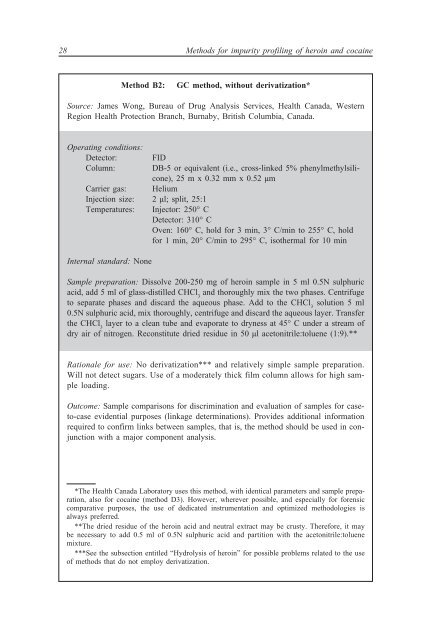methods for impurity profiling of heroin and cocaine - United Nations ...
methods for impurity profiling of heroin and cocaine - United Nations ...
methods for impurity profiling of heroin and cocaine - United Nations ...
Create successful ePaper yourself
Turn your PDF publications into a flip-book with our unique Google optimized e-Paper software.
28 Methods <strong>for</strong> <strong>impurity</strong> <strong>pr<strong>of</strong>iling</strong> <strong>of</strong> <strong>heroin</strong> <strong>and</strong> <strong>cocaine</strong><br />
Method B2: GC method, without derivatization*<br />
Source: James Wong, Bureau <strong>of</strong> Drug Analysis Services, Health Canada, Western<br />
Region Health Protection Branch, Burnaby, British Columbia, Canada.<br />
Operating conditions:<br />
Detector: FID<br />
Column: DB-5 or equivalent (i.e., cross-linked 5% phenylmethylsilicone),<br />
25 m x 0.32 mm x 0.52 µm<br />
Carrier gas: Helium<br />
Injection size: 2 µl; split, 25:1<br />
Temperatures: Injector: 250° C<br />
Detector: 310° C<br />
Oven: 160° C, hold <strong>for</strong> 3 min, 3° C/min to 255° C, hold<br />
<strong>for</strong> 1 min, 20° C/min to 295° C, isothermal <strong>for</strong> 10 min<br />
Internal st<strong>and</strong>ard: None<br />
Sample preparation: Dissolve 200-250 mg <strong>of</strong> <strong>heroin</strong> sample in 5 ml 0.5N sulphuric<br />
acid, add 5 ml <strong>of</strong> glass-distilled CHCl 3 <strong>and</strong> thoroughly mix the two phases. Centrifuge<br />
to separate phases <strong>and</strong> discard the aqueous phase. Add to the CHCl 3 solution 5 ml<br />
0.5N sulphuric acid, mix thoroughly, centrifuge <strong>and</strong> discard the aqueous layer. Transfer<br />
the CHCl 3 layer to a clean tube <strong>and</strong> evaporate to dryness at 45° C under a stream <strong>of</strong><br />
dry air <strong>of</strong> nitrogen. Reconstitute dried residue in 50 µl acetonitrile:toluene (1:9).**<br />
Rationale <strong>for</strong> use: No derivatization*** <strong>and</strong> relatively simple sample preparation.<br />
Will not detect sugars. Use <strong>of</strong> a moderately thick film column allows <strong>for</strong> high sample<br />
loading.<br />
Outcome: Sample comparisons <strong>for</strong> discrimination <strong>and</strong> evaluation <strong>of</strong> samples <strong>for</strong> caseto-case<br />
evidential purposes (linkage determinations). Provides additional in<strong>for</strong>mation<br />
required to confirm links between samples, that is, the method should be used in conjunction<br />
with a major component analysis.<br />
*The Health Canada Laboratory uses this method, with identical parameters <strong>and</strong> sample preparation,<br />
also <strong>for</strong> <strong>cocaine</strong> (method D3). However, wherever possible, <strong>and</strong> especially <strong>for</strong> <strong>for</strong>ensic<br />
comparative purposes, the use <strong>of</strong> dedicated instrumentation <strong>and</strong> optimized methodologies is<br />
always preferred.<br />
**The dried residue <strong>of</strong> the <strong>heroin</strong> acid <strong>and</strong> neutral extract may be crusty. There<strong>for</strong>e, it may<br />
be necessary to add 0.5 ml <strong>of</strong> 0.5N sulphuric acid <strong>and</strong> partition with the acetonitrile:toluene<br />
mixture.<br />
***See the subsection entitled “Hydrolysis <strong>of</strong> <strong>heroin</strong>” <strong>for</strong> possible problems related to the use<br />
<strong>of</strong> <strong>methods</strong> that do not employ derivatization.

















